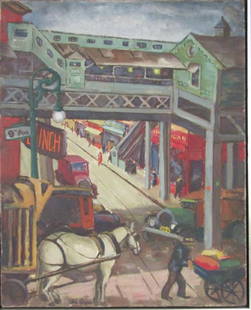
Amazing John Opper Oil Canvas
John Opper Sale History
View Price Results for John OpperRelated Paintings
More Items in Paintings
View MoreRecommended Art
View More



Item Details
Description
Attributed to John Opper, it does not have a COA. Medium: oil canvas. 23 x 19 inches. Provenance: private owner.
Biography: 1908 - 1994. Academically trained like many of his contemporaries, Opper came to New York in 1934, two years after his graduation from Case Western Reserve University in Cleveland, Ohio. As a youth, he had taken Saturday art classes at the Cleveland Museum of Art and later studied at the Cleveland School of Art and the School of the Art Institute of Chicago. When he arrived in New York he was a well-trained painter, adept at rendering still lifes and particularly landscapes depicting the American scene. A reviewer of his 1937 exhibition at the Artists' Gallery in New York, for example, wrote about Opper's "colloquial flavor . . . spontaneity and an imaginative use of color which conveys just the feeling" which the subjects-East River tugboats, old garages, and scenes around Manhattan-suggest. [3]By 1937 Opper had become familiar with modernism, though he was not yet converted to the cause. Indeed, his 1937 show was made up of the still popular regionalist paintings. Earlier, in 1935 and 1936, he studied with Hans Hofmann and began to think in terms of forces and tensions within the picture plane. He met Wilfrid Zogbaum, Giorgio Cavallon, Byron Browne, Rosalind Bengelsdorf, and George McNeil, with whom he shared a studio. He paid frequent visits to Gallatin's Gallery of Living Art. He joined the WPA easel project in 1936 and began to paint in "a kind of transformed cubist style."[4]For Opper, though, abstraction conflicted philosophically with a strong commitment to social reform. He belonged to the American Artists' Congress and, when it was first formed, served as business manager of Art Front, the Artists' Union publication. He also exhibited with the American Abstract Artists, but eventually dropped out of the group. Opper said he preferred to combine creative work with social comment and was as yet unwilling to do completely abstract art. During the early 1940s, he noted, he was torn "between the needs of the society and the needs of war on one hand, and on . . . what I felt were the aesthetic needs of painting."[5] Only when he resolved to separate these two, did he begin systematically to pursue abstract work. Eventually, he came to believe that the only thing important to art "is that which changes . . . the language and the substance of it."When war came, Opper worked for three years with a marine architectural firm making drawings for the pipe systems of PT boats. After the war, he taught at the University of Wyoming and the University of Alabama, and between 1952 and 1957, he was on the faculty at the University of North Carolina. In 1957, he began teaching at New York University, where he remained until his retirement in 1974.Opper had two one-man exhibitions during the late 1930s, but it was not until the 1940s that he began to show frequently in large museum exhibitions and receive widespread attention. For Opper, this was a time of maturity.In paintings such as Farmyard (1937), his abstraction was based on nature; Wyoming, however, represents a major conceptual step. By 1947, when it was painted, Opper was committed to the idea that "painting is concerned with painting," an end in itself rather than a means to communicate other concerns. Early on he was allied with the "intuitive" (rather than the rationally inclined) faction within the American Abstract Artists. But Opper moved far afield stylistically from the densely painted, expressionistic works of the 1930s and 1940s. In time, he became known as an Abstract Expressionist, a painter of large canvases in which vertical bands of varying widths pulsed with color. His gesture was controlled, yet dynamic; his overlays of color luminous and tactile. In these works, and in field paintings in which clouds of color seem to float against soft grounds, he strengthened his commitment to "painting as painting" that he first developed as a Hofmann student.
All authorship of items in this catalog are described according to the following terms:
Signed [Artist Name] : In cases in which the signature is legible in the lot, this work is described as-is with no attributions given.
By [Artist Name] : The work is by the artist.
Attributed to [Artist Name] : The work may be ascribed to the artist on the basis of style, but there may be some question as to actual authorship.
In the manner of [Artist Name] : The work was executed by an unknown hand, but was designed deliberately to emulate the style of the artist.
After [Artist Name] : The work was executed by an unknown hand, but is a deliberate copy of a known work by the artist.
Circle of [Artist Name] : A work of the period of the artist showing his influence, closely associated with the artist but not necessarily his pupil.
Follower of [Artist Name]: A work by a pupil or a follower of the artist (not necessarily a pupil).
American, 19th century: This work was executed by an unknown hand, and can only be identified by origin (i.e., region, period).
Biography: 1908 - 1994. Academically trained like many of his contemporaries, Opper came to New York in 1934, two years after his graduation from Case Western Reserve University in Cleveland, Ohio. As a youth, he had taken Saturday art classes at the Cleveland Museum of Art and later studied at the Cleveland School of Art and the School of the Art Institute of Chicago. When he arrived in New York he was a well-trained painter, adept at rendering still lifes and particularly landscapes depicting the American scene. A reviewer of his 1937 exhibition at the Artists' Gallery in New York, for example, wrote about Opper's "colloquial flavor . . . spontaneity and an imaginative use of color which conveys just the feeling" which the subjects-East River tugboats, old garages, and scenes around Manhattan-suggest. [3]By 1937 Opper had become familiar with modernism, though he was not yet converted to the cause. Indeed, his 1937 show was made up of the still popular regionalist paintings. Earlier, in 1935 and 1936, he studied with Hans Hofmann and began to think in terms of forces and tensions within the picture plane. He met Wilfrid Zogbaum, Giorgio Cavallon, Byron Browne, Rosalind Bengelsdorf, and George McNeil, with whom he shared a studio. He paid frequent visits to Gallatin's Gallery of Living Art. He joined the WPA easel project in 1936 and began to paint in "a kind of transformed cubist style."[4]For Opper, though, abstraction conflicted philosophically with a strong commitment to social reform. He belonged to the American Artists' Congress and, when it was first formed, served as business manager of Art Front, the Artists' Union publication. He also exhibited with the American Abstract Artists, but eventually dropped out of the group. Opper said he preferred to combine creative work with social comment and was as yet unwilling to do completely abstract art. During the early 1940s, he noted, he was torn "between the needs of the society and the needs of war on one hand, and on . . . what I felt were the aesthetic needs of painting."[5] Only when he resolved to separate these two, did he begin systematically to pursue abstract work. Eventually, he came to believe that the only thing important to art "is that which changes . . . the language and the substance of it."When war came, Opper worked for three years with a marine architectural firm making drawings for the pipe systems of PT boats. After the war, he taught at the University of Wyoming and the University of Alabama, and between 1952 and 1957, he was on the faculty at the University of North Carolina. In 1957, he began teaching at New York University, where he remained until his retirement in 1974.Opper had two one-man exhibitions during the late 1930s, but it was not until the 1940s that he began to show frequently in large museum exhibitions and receive widespread attention. For Opper, this was a time of maturity.In paintings such as Farmyard (1937), his abstraction was based on nature; Wyoming, however, represents a major conceptual step. By 1947, when it was painted, Opper was committed to the idea that "painting is concerned with painting," an end in itself rather than a means to communicate other concerns. Early on he was allied with the "intuitive" (rather than the rationally inclined) faction within the American Abstract Artists. But Opper moved far afield stylistically from the densely painted, expressionistic works of the 1930s and 1940s. In time, he became known as an Abstract Expressionist, a painter of large canvases in which vertical bands of varying widths pulsed with color. His gesture was controlled, yet dynamic; his overlays of color luminous and tactile. In these works, and in field paintings in which clouds of color seem to float against soft grounds, he strengthened his commitment to "painting as painting" that he first developed as a Hofmann student.
All authorship of items in this catalog are described according to the following terms:
Signed [Artist Name] : In cases in which the signature is legible in the lot, this work is described as-is with no attributions given.
By [Artist Name] : The work is by the artist.
Attributed to [Artist Name] : The work may be ascribed to the artist on the basis of style, but there may be some question as to actual authorship.
In the manner of [Artist Name] : The work was executed by an unknown hand, but was designed deliberately to emulate the style of the artist.
After [Artist Name] : The work was executed by an unknown hand, but is a deliberate copy of a known work by the artist.
Circle of [Artist Name] : A work of the period of the artist showing his influence, closely associated with the artist but not necessarily his pupil.
Follower of [Artist Name]: A work by a pupil or a follower of the artist (not necessarily a pupil).
American, 19th century: This work was executed by an unknown hand, and can only be identified by origin (i.e., region, period).
Condition
Mint based on the description
Buyer's Premium
- 25% up to $200.00
- 25% up to $300.00
- 25% above $300.00
Amazing John Opper Oil Canvas
Estimate $6,000 - $12,000
11 bidders are watching this item.
Shipping & Pickup Options
Item located in Riverview, FL, usSee Policy for Shipping
Payment
Accepts seamless payments through LiveAuctioneers

TOP



















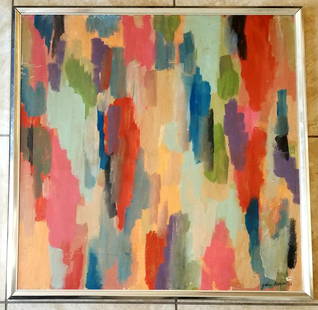
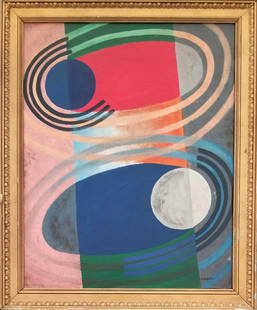


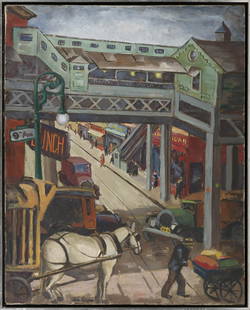

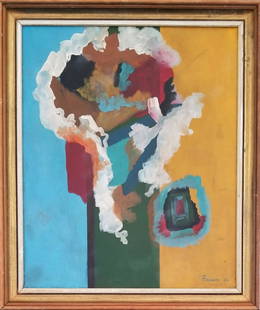

![Amazing John Hogan Impressionism Oil Canvas: John Hogan oil canvas. 71 x 63 inches. Provenance: private owner. All authorship of items in this catalog are described according to the following terms: Signed [Artist Name] : In cases in which the s](https://p1.liveauctioneers.com/6985/215363/110349685_1_x.jpg?height=310&quality=70&version=1629595380)
